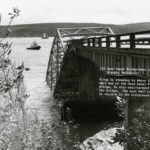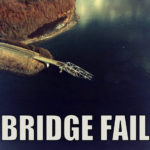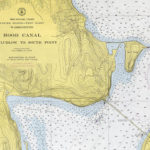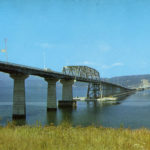The windstorm that sank the Hood Canal Bridge in 1979
Feb 13, 2024, 6:45 AM | Updated: 6:49 am
Originally published February 13, 2019
Jim MacDonald was 31-year old radio announcer back in February 1979 when he took a phone call from a listener with news that changed the lives of thousands of people on the Olympic Peninsula for years.
MacDonald was working at KONP 1450 in Port Angeles. It was his third radio job, after stints at KAAR in Yakima and KOMW in Omak. The “ONP” in the Port Angeles station’s call-letters stood for “Olympic National Park,” because the station’s founder, Charles Webster, had been a booster of the effort to create that park back in the 1930s.
KONP in those years played “Adult Contemporary,” or music of the popular yet soft-rocking variety. In February 1979, Anne Murray topped the “AC” charts with “I Just Fall In Love Again.” A few weeks later, Poco’s “Crazy Love” would knock Murray out of first place. But KONP, and pretty much every radio station back then, had more going out over the airwaves than just music.
“We were an ABC affiliate, so we had ABC News. We had our local news at the top of every hour and local weather, we had all those kinds of things,” MacDonald said earlier this week, from his home in Anacortes. “We broadcast a lot of sports, too. We had high school sports, we had the University of Washington Huskies, Mariners, Seahawks.”
Early on the morning of February 13, 1979, KONP had its usual skeleton crew of two. Radio is a notoriously, shall we say, cost-conscious business, and radio people are used to making do with minimal resources.
“There were just two people at the station, just myself and the news director,” MacDonald said. “And at the time [when I got the call], the news director [whose name was Neal Clement] was doing the news from his studio, and I was answering the phone.”
Of course, this was many years before online social media, when local radio functioned as a kind of analog, real-time social media and internet all rolled into one. For instance, in 1979, the only way you could get 24-hour news updates was to have a Associated Press or United Press International teletype installed in your home.
Or, you could just call your local radio station.
More from Feliks Banel: Ryan House in Sumner named “Most Endangered”
“So I get a phone call,” MacDonald said. “And so I answer the phone, and it’s Marge Pieratt. Marge is a loyal listener and a friend of ours. And she tells me, she says, ‘You know, my sister lives above the Hood Canal Bridge, and she just called me and said the bridge has sunk.'”
MacDonald was incredulous.
“My first thought is, ‘No … seriously?'” MacDonald said. “And she said, ‘Yeah, [my sister] said that the bridge is gone.’ So I said, ‘OK Marge, we’ll follow up on that.'”
Even though the tip had come from a trusted friend, Jim MacDonald knew couldn’t just go on the air from KONP with what was essentially a rumor.
“When the news director got off the air, I told him about the call, and he called the Port Angeles detachment of the State Patrol,” MacDonald said. “As you might expect, they were in the throes of the whole thing, too, but they did confirm to us that a portion of the bridge had gone down, and they were still trying to figure out how much of the bridge had gone down, and all sorts of other things, because their office was going crazy.”
Little KONP in little Port Angeles had the scoop of the century, as far as any other story that would impact the Olympic Peninsula, before or since.
“I mean, we probably had it on the air, confirmed, within 15 minutes of the bridge going down,” MacDonald said.
The Hood Canal Bridge had opened to vehicle traffic in 1961 after three years of construction. It was Washington’s second floating bridge, coming 21 years after the Lacey V. Murrow Bridge carrying what is now I-90 across Lake Washington at Mercer Island, and two years before the Albert Rosellini Evergreen Point 520 Floating Bridge between Medina and Montlake.
Total cost of the 1.3 mile span was $25 million in 1961, or the equivalent of about $210 million in 2019 dollars. The Hood Canal Bridge connected the Kitsap Peninsula and Olympic Peninsula across the mouth of Hood Canal; prior to the bridge, a Washington State Ferry carried vehicles and passengers from Lofall on the Kitsap County side to South Point on the Jefferson County side.
What made the Hood Canal Bridge sink?
On the night of Monday, February 12, 1979, the region was struck by a classic Puget Sound wind event. A low pressure system moved across the area just north of Puget Sound and essentially drained all the air from Western Washington like a massive bathtub. High winds blew throughout the area, with downed trees and widespread power outages.
The bridge was buffeted by high winds beginning late that Monday evening. Around 11 p.m., Washington State Department of Transportation (WSDOT) crews on the bridge closed it to vehicle traffic and opened the drawspan in the middle of the bridge to relieve pressure. They closed the drawspan briefly around 2 a.m. to let a Puget Power crew cross, and then opened up the drawspan again.
On either side of the drawspan, the Hood Canal Floating Bridge (which is very similar to the original 1940 I-90 and 1963 520 floating bridges) consisted of a series of floating concrete pontoons connected to each other, and to a “highrise” at the west and east ends of the bridge. The pontoons were also connected via steel cables to concrete anchors set into the bottom of Hood Canal.
Around 6 a.m. on February 13, the wind was gusting from the south at over 100 mph. The floating pontoons on the west half of the bridge began taking on water and listing around 6:40 a.m. Around 7:15 a.m., the western section, including Pontoons A through M – each 360 feet long, broke loose, drifted slightly north, and then rolled over and sank to the bottom of Hood Canal. The western highrise hinged down into the water, but stayed attached to the concrete approach to the west end of the bridge.
Chuck Myers was a WSDOT employee on duty at the bridge that morning.
“I knew this was worse than any other storm we’d had. It was the combination of factors,” Myers told The Seattle Times. “We’d had winds worse than this, and currents worse. But we’d never had both at the same time.”
Another WSDOT staffer on duty that day was George Tyner.
“This storm was the worst for the swells, with the winds working against the tide,” Tyner told The Seattle Times. “Plus we were working with a low tide, so the anchor cables for the bridge were more slack, permitting more movement.”
Myers and Tyner escaped from the bridge in Tyner’s truck, arriving on the west bank of Hood Canal shortly before the bridge sank.
Losing “a great old car”
In the immediate aftermath of the bridge sinking, Jim MacDonald said KONP had to bring in extra people that day to help answer the phones.
“We got a lot of phone calls,” MacDonald said. “In fact, I don’t remember exactly how many, [but] we had to call people in to man the phones because everybody was calling the radio station to find out what was going on, even though we were [talking about] it on the air. It was pretty crazy.”
Fortunately, nobody was injured or killed when the Hood Canal Bridge went down.
However, newspaper accounts at the time say that four or five passenger cars and a semi-truck had barely made it off the west section of pontoons before the pontoons broke loose and sank. Those cars and that truck had been waiting for the bridge to reopen to vehicle traffic. WSDOT employee Chuck Myers told The Seattle Times that he blamed a Jefferson County Sheriff’s Deputy for not remaining at the west end of the bridge to keep vehicles from driving out onto the floating portion. The semi truck driver, a man named Red Taylor, apparently had a difficult time backing his truck off the bridge, but he managed to do it, by all accounts, in barely the nick of time. A few other WSDOT trucks weren’t so lucky; they went to the bottom of Hood Canal.
And WSDOT employee Chuck Myers did lose what sounds like a treasured possession in the Hood Canal Bridge sinking: his 1967 Plymouth that had been parked on one of the western pontoons. It was “a great old car,” Myers told The Seattle Times.
And though there were no human casualties, the loss of the bridge deeply affected Jefferson County and Clallam County, and much of the northern portion of Olympic Peninsula. There was no simple solution for where to send the average 6,000 vehicles per day that had crossed the span.
“It impacted everybody a lot,” Jim MacDonald said. “It took them a few weeks before they got some ferry service across the canal. And the ferry service was basically a barge that was pushed across by a tugboat. And until they got that going the only way you could really get to Seattle was head on down the Hood Canal all the way down to Olympia through Shelton and back up I-5 or you could go to Bremerton and take a ferry to Seattle.”
Ferry service was eventually also offered between Edmonds and Port Townsend, and then the repaired bridge opened officially on Sunday, October 24, 1982, though traffic had been allowed across the day before. Lucky-to-be-alive semi driver Red Taylor was one of the first to cross.
More from Feliks Banel: Remembering how Boeing helped bring The Beatles to America for their first-ever visit
Total cost of the new western section was $150 million or $390 million in 2019 dollars. The original eastern half was replaced in 2009 for $500 million.
Jim MacDonald is retired now; he and his wife ultimately bought KONP, as well as Port Angeles station KAPY. They sold both stations in 2002 and eventually relocated to Anacortes.
Back in 2019, Claudia Bingham Baker of WSDOT confirmed to KIRO Newsradio, perhaps not surprisingly, that the agency had no plans to observe the 40th anniversary of the loss of the bridge.
And what happened to all the wreckage from the 1979 sinking?
Baker said via email that “the bridge’s pontoons and concrete gravity anchors were left on the bottom of the canal. The elevated concrete superstructure on the pontoons was broken into rubble so it would not interfere with the new pontoons and anchoring system; any rubble that would interfere with the anchoring system was removed. The steel anchor cables and bridals were removed.”
But what became of Chuck Myers’ beloved 1967 Plymouth?
“I don’t know if the vehicle was recovered,” Baker wrote. “I can tell you that we’ve not found any vehicles in any of the underwater surveys we’ve done since then.”
Editor’s note: Special thanks to Benjamin Helle of the Washington State Archives for assistance with images for this story.
You can hear Feliks every Wednesday and Friday morning on Seattle’s Morning News with Dave Ross and Colleen O’Brien, read more from him here, and subscribe to The Resident Historian Podcast here. If you have a story idea or a question about Northwest history, please email Feliks here.




















